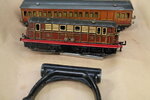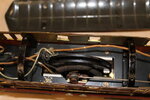Thanks again Magnetoman for the excellent information, just another query on the same issue if I might: When a generator armature is undergoing commutation, while under load, the armature reaction caused by the current flowing distorts the main field so that the brushes no longer line up with the neutral plane, I thought that maybe the collapsing magnetic field in the armature coils (which now have a voltage induced in them because of armature reaction) could produce a voltage much higher than the 6 Volts?That's an excellent question. I don't know the equivalent in Australia (maybe the same?), but in the U.S. in the 1950s boys grew up with Lionel electric train sets. I can still smell the odor of what I now know is ozone from those trains. So, since a motor is just a generator operated backwards, doesn't this mean our dynamos are generating ozone as well? The answer is essentially no, but to understand the reason requires a short physics lecture.
Ozone is created when the chemical bond in an oxygen molecule (02) is broken, creating two individual oxygen atoms that are each now free to chemically bond to intact 02 molecules to form ozone (O3). The minimum energy that must be supplied to break the chemical bond in O2 to get this started is 5.2 electron Volts.(eV). While your 6V dynamo nominally is capable of this when at maximum output, the efficiency of doing so is small so near the threshhold voltage, so very little ozone is generated. A Lionel train operated at ~20 V when at full speed, and what boy operated his train at anything other than full speed? (note: Volt and eV are not the same units, but they are related in that an electron accelerated between two electrodes held at a 20 V potential difference will gain 20 eV of energy).
In contrast, the potential across the points in a magneto is several hundred volts when they open, which is far enough higher than the threashold to make for greatly increased ozone production. Further, the ionization cross section (i.e. the probability an energetic electron will knock another electron free from a molecule thus creating an ion) for most molecules has a broad peak centered around ~100 Volts. So, molecules in the vicinity of the spark gap in a magneto are being ionized with great efficiency as well, and ionized species are typically much more chemically reactive than unionized atoms and molecules.
Having given the long answer to your question, the short answer is that because the voltages inside a dynamo are much lower than inside the points housing of a magneto, ozone production is at a very much lower rate. The much lower production of ozone, coupled with the fact he commutator housing is far from hermetically sealed, means it isn't an issue for a dynamo.
Feel free to shoot this notion down in flames
Thanks and regards
Kevin


